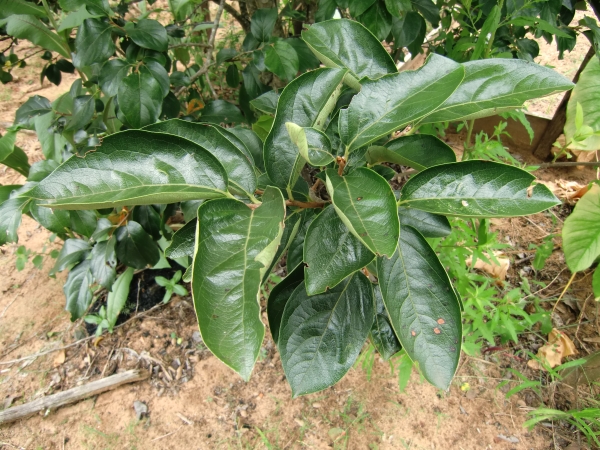

Diospyros kaki (Persimmon)
One deciduous tree from the genus Diospyros and from the family Ebenaceae with tomato-like large fruits. The persimmon is native to China, was cultivated for more than 2000 years in China.
The blossoms are yellow and 0.8 to 1.0 inches (2 to 2.5 cm), they appear in the early summer, have four crownshaped sepals. When the sepals are opening, the blossoms appears like one whitish yellow almond. This blossoms opens after further some days, 4 sepals which are looking like one china-coloured crown. They also can form fruits without pollinating, which are then seedless, this is also found at bananas. If they are pollinated, then the fruits will contain seeds and will be some larger.
The spherical to oval fruit has four sepals at the indented stem edge and weighs to 500 g. The smooth, glossy and thin peel is yellow to reddish-orange. The some lighter fruit pulp can contain to eight seeds. The fruit become softier with progessive ripeness, like one kiwi fruit.
The high tannin content in the still not completely ripen frut causes one taste which does remember to pear and apricot, with progessively ripening it becomes weaker. The furry taste disappears during the process of ripening, also with frost. In Brazil there is no frost in the most regions, also in our garden there are no frosts occurring, therefore the fruits could ripen further alternatively in the refrigerator. The high amount of beta-carotin (provitamin A) makes it valuable, of all for eye problems.
The tree is longliving and also pest resistant, offers nesting places for birds in Asia. The persimmon fruit can eaten in-kind, the fruit pulp can also spooned out. The tree is also hardy in milder regions of Germany.
The specimen we had received by purchasing of our yard.

Diospyros kaki in our garden in December 2009.

Close-up view ouf the leaves of Diospyros kaki.
Back to the Agricultural Plant List
Updated by Joachim Jaeck on April 2nd, 2011